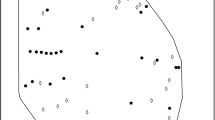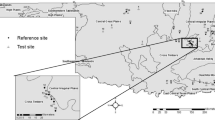Abstract
Floristic quality assessment is potentially an important tool for conservation efforts in the northern Great Plains of North America, but it has received little rigorous evaluation. Floristic quality assessments rely on coefficients assigned to each plant species of a region’s flora based on the conservatism of each species relative to others in the region. These “coefficients of conservatism” (C values) are assigned by a panel of experts familiar with a region’s flora. The floristic quality assessment method has faced some criticism due to the subjective nature of these assignments. To evaluate the effect of this subjectivity on floristic quality assessments, we performed separate evaluations of the native plant communities in a natural wetland complex and three restored wetland complexes. In our first assessment, we used C values assigned “subjectively” by the Northern Great Plains Floristic Quality Assessment Panel. We then performed an independent assessment using the observed distributions of species among a group of wetlands that ranged from highly disturbed to largely undisturbed (data-generated C values). Using the panel-assigned C values, mean C values (\(\bar C\)) of the restored wetlands rarely exceeded 3.4 and never exceeded 3.9, with the highest values occurring in the oldest restored complex; all but two wetlands in the natural wetland complex had a \(\bar C\) greater than 3.9. Floristic quality indices (FQI) for the restored wetlands rarely exceeded 22 and usually reached maximums closer to 19, with higher values occurring again in the oldest restored complex; only two wetlands in the natural complex had an FQI less than 22. We observed that 95% confidence limits for species richness and percent natives overlapped greatly among wetland complexes, whereas confidence limits for both \(\bar C\) and FQI overlapped little. \(\bar C\) and FQI values were consistently greater when we used the datagenerated C values than when we used the panel-assigned C values; nonetheless, conclusions reached based on these two independent assessment techniques were virtually identical. Our results are consistent with the opinion that coefficients assigned subjectively by expert botanists familiar with a region’s flora provide adequate information to perform accurate floristic quality assessments.
Similar content being viewed by others
Literature Cited
Andreas, B. K. and R. W. Lichvar. 1995. Floristic index for establishing assessment standards: a case study for northern Ohio. U.S. Army Corps of Engineers, Waterways Experiment Station, Vicksburg, MS, USA. Technical Report WRP-DE-8.
Dahl, T. E. 1990. Wetland losses in the United States 1780’s to 1980’s. U.S. Department of interior, Fish and Wildlife Service, Washington, DC, USA.
D’Avanzo, C. 1990. Long-term evaluation of wetland creation projects. p. 487–496. In J. A. Kusler and M. E. Kentula (eds.) Wetland Creation and Restoration; the Status of the Science. Island Press, Washington, DC, USA.
Euliss, N. H., Jr., D. A. Wrubleski, and D. M. Mushet. 1999. Wetlands of the prairie pothole region—invertebrate species composition, ecology, and management. p. 471–514. In D. P. Batzer, R. B. Rader, and S. A. Wissinger (eds.) Invertebrates in Freshwater Wetlands of North America—Ecology and Management. John Wiley and Sons, Inc., New York, NY, USA.
Galatowitsch, S. M. and A. G. van der Valk. 1996. The vegetation of restored and natural prairie wetlands. Ecological Applications 6:102–112.
Gleason, R. A. 2001. Invertebrate egg and plant seed banks in natural, restored, and drained wetlands in the prairie pothole region (USA) and potential effects of sedimentation on recolonization of hydrophytes and aquatic invertebrates. Ph.D. Dissertation. South Dakota State University, Brookings, SD, USA.
Gleason, R. A. and N. H. Euliss, Jr. 1998. Sedimentation of prairie wetlands. Great Plains Research 8:97–112.
Grue, C. E., M. W. Tome, T. A. Messmer, D. B. Henry, G. A. Swanson, and L. R. DeWeese. 1989. Agricultural chemicals and prairie pothole wetlands: meeting the needs of the resource and the farmer—U.S. perspective. Transactions of the North American Wildlife and Natural Resources Conference 54:43–58.
Hanson, B. A. and G. A. Swanson. 1989. Coleoptera species inhabiting prairie wetlands of the Cottonwood Lake area, Stutsman County, North Dakota. Prairie Naturalist 21:49–57.
Herman, K. D., L. A. Masters, M. R. Penskar, A. A. Reznicek, G. S. Wilhelm, and W. W. Brodowicz. 1997. Floristic quality assessment: development and application in the state of Michigan (USA). Natural Areas Journal 17:265–279.
Horner, R. R. and K. J. Raedeke. 1989. Guide for wetland mitigation projects monitoring. Washington State Department of Transportation, Seattle, WA, USA. Report Number WA-RD 195.1.
Kantrud, H. A., J. B. Millar, and A. G. van der Valk. 1989. Vegetation of wetlands in the prairie pothole region. p. 132–187. In A. van der Valk (ed.) Northern Prairie Wetlands. Iowa State University Press, Ames, IA, USA.
Kantrud, H. A. and W. E. Newton. 1996. A test of vegetation-related indicators of wetland quality in the prairie pothole region. Journal of Aquatic Ecosystem Health 5:177–191.
LaBaugh, J. W., T. C. Winter, V. A. Adomaitis, and G. A. Swanson. 1987. Hydrology and chemistry of selected prairie wetlands in the Cottonwood Lake area, Stutsman County, North Dakota, 1979–82. U.S. Geological Survey Professional Paper 1431.
Ladd, D. M. 1993. coefficients of conservatism for missouri vascular flora. The Nature Conservancy, St. Louis, MO, USA.
Martin, D. B. and W. A. Hartman. 1986. The effect of cultivation on sediment and deposition in prairie pothole wetlands. Water, Air, and Soil Pollution 34:45–53.
Nelson, R. D. and M. G. Butler. 1987. Seasonal abundance of larval and adult chironomids (Diptera: Chironomidae) in four prairie wetlands. Proceedings of the North Dakota Academy of Science 41:31.
Northern Great Plains Floristic Quality Assessment Panel. 2001. Coefficients of conservatism for the vascular flora of the Dakotas and adjacent grasslands. U.S. Geological Survey, Biological Resources Division, Information and Technology Report USGS/BRD/ITR-2001-0001.
Poiani, K. A. and W. C. Johnson. 1988. Evaluation of the emergence method in estimating seed bank composition of prairie wetlands. Aquatic Botany 32:91–97.
Snedecor, G. W., and W. G. Cochran. 1980. Statistical Methods. seventh edition. Iowa State University Press, Ames, IA, USA.
Stewart, R. E. and H. A. Kantrud. 1971. Classification of natural ponds and lakes in the glaciated prairie region. U.S. Fish and Wildlife Service Resource Publication 92.
Swanson, K. D. 1990. Chemical evolution and ground water in clay till in a prairie wetland setting in the Cottonwood Lake area, Stutsman County, North Dakota. M.S. Thesis. University of Wisconsin, Madison, WI, USA.
Swink, F. A. and G. S. Wilhelm. 1979. Plants of the Chicago Region, Revised and Expanded Edition with Keys. Morton Arboretum, Lisle, IL, USA.
Swink, F. A. and G. S. Wilhelm. 1994. Plants of the Chicago Region, Fourth Edition. Indiana Academy of Science, Indianapolis, IN, USA.
Taft, J. B., G. S. Wilhelm, D. M. Ladd, and L. A. Masters. 1997. Floristic quality assessment for vegetation in Illinois, a method for assessing vegetation integrity. Erigenia 15:3–95.
USDA, NRCS. 2001. The PLANTS database, version 3.1 (http://plants.usda.gov). National Plant Data Center, Baton Rouge, LA, USA.
Wilhelm, G. S. and D. Ladd. 1988. Natural area assessment in the Chicago region. Transactions of the North American Wildlife and Natural Resources Conference 53:361–375.
Winter, T. C. and M. R. Carr. 1980. Hydrologic setting of wetlands in the Cottonwood Lake area, Stutsman County, North Dakota U.S. Geological Survey Water-Resources Investigation 80–99.
Winter, T. C. and D. O. Rosenberry. 1995. The interactions of groundwater with prairie pothole wetlands in the Cottonwood Lake area, east-central North Dakota, 1979–1990. Wetlands 15: 193–211.
Author information
Authors and Affiliations
Rights and permissions
About this article
Cite this article
Mushet, D.M., Euliss, N.H. & Shaffer, T.L. Floristic quality assessment of one natural and three restored wetland complexes in North Dakota, USA. Wetlands 22, 126–138 (2002). https://doi.org/10.1672/0277-5212(2002)022[0126:FQAOON]2.0.CO;2
Received:
Revised:
Accepted:
Issue Date:
DOI: https://doi.org/10.1672/0277-5212(2002)022[0126:FQAOON]2.0.CO;2




